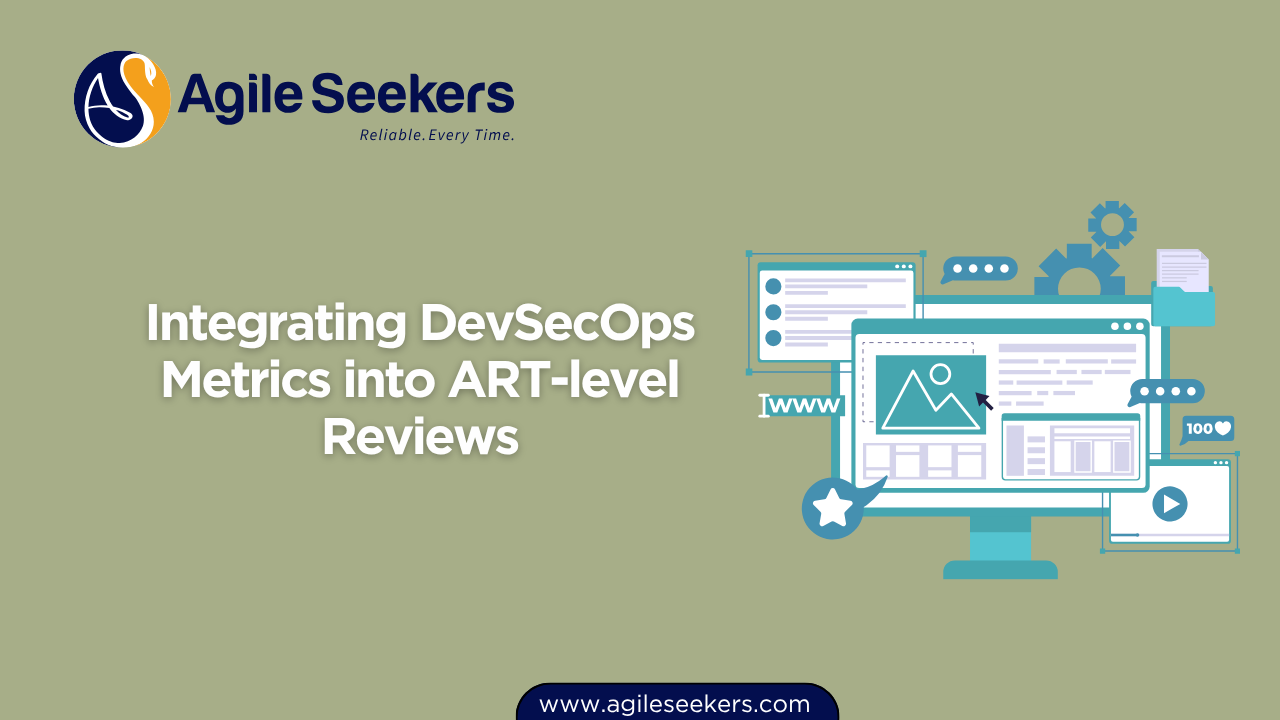Integrating DevSecOps Metrics into ART-level Reviews

In SAFe environments, Agile Release Trains (ARTs) are responsible for delivering value continuously through coordinated teams. As organizations embrace DevSecOps practices, it's no longer enough to just track functional progress. Security, compliance, and resilience must also be part of the feedback loop. This is where integrating DevSecOps metrics into ART-level reviews becomes essential.
This blog explores how DevSecOps metrics can be integrated meaningfully into ART ceremonies and reviews, helping ensure security is not an afterthought but an embedded practice in SAFe delivery.
Why DevSecOps Metrics Matter in SAFe ARTs
DevSecOps focuses on embedding security throughout the software delivery pipeline, from development to deployment. Without proper metrics, ARTs can’t identify bottlenecks, compliance risks, or vulnerabilities early. Metrics enable measurable improvements across:
- Security posture
- Automated compliance
- Incident recovery
- Deployment integrity
- Team accountability
Integrating DevSecOps indicators during ART-level reviews brings security into the same continuous feedback loop as features, bugs, and technical debt.
Types of DevSecOps Metrics to Integrate
To ensure consistency and relevance, organizations should align on a standard set of DevSecOps metrics. Below are key metrics ARTs can track:
1. Vulnerability Detection Rate
This tracks how many security issues are identified across code, dependencies, and infrastructure per iteration. Tools like Snyk or OWASP Dependency-Check can support this.
2. Mean Time to Remediate (MTTR)
Measures how quickly vulnerabilities are fixed after detection. High MTTR may indicate poor response processes or lack of prioritization.
3. Security Test Coverage
Percentage of code or components covered by security tests. This could include SAST, DAST, and IaC scans integrated into CI/CD pipelines.
4. Policy Violations
Metrics that flag non-compliance with organizational security policies, such as hardcoded secrets, open ports, or missing encryption.
5. Deployment Risk Score
A composite score based on failed tests, code quality, unapproved changes, or risky config changes. Tools like ShiftLeft can assist in generating risk ratings pre-deployment.
6. Change Failure Rate (Security-specific)
Tracks what percentage of changes introduce security regressions or failures in production.
Embedding DevSecOps Metrics in ART Events
To bring DevSecOps into the daily rhythm of the ART, you must embed these metrics in standard ceremonies and reviews:
1. PI Planning
Product Management and System Architects should include security-related features or enablers in the Program Backlog. Risks should be logged and shared using ROAM boards.
2. System Demos
System Demos should showcase not just functional progress but also improvements in security metrics—like reduction in critical vulnerabilities or improved test coverage.
3. Inspect & Adapt Workshops
This is the most critical point for ART-level metric review. DevSecOps metrics should be part of the Quantitative and Qualitative Measurement section. For example:
- Compare MTTR across teams
- Highlight spikes in policy violations
- Review coverage gaps across pipelines
Including this aligns with the SAFe DevSecOps recommendations on continuous security validation and compliance.
Using DevSecOps Dashboards for ART Transparency
Rather than waiting for a single event, transparency should be continuous. Building a dashboard that visualizes key DevSecOps metrics by team or by Program Increment (PI) helps ART leaders respond proactively. Tools like Grafana or Datadog can integrate with CI/CD and monitoring pipelines.
Sample visualizations include:
- Security test pass/fail trends over time
- Vulnerability age distribution
- Change Failure Rate segmented by application team
These dashboards can be referenced during ART Sync meetings, ART-level Scrum of Scrums, and Solution Train events when applicable.
Challenges in Adoption
While integrating DevSecOps metrics has obvious benefits, organizations often face the following challenges:
- Lack of automation: Manual security testing leads to delays and skipped scans.
- Tool fragmentation: Security tools may not integrate well with ART dashboards.
- Cultural resistance: Development teams may see security as a blocker rather than an enabler.
- Misaligned incentives: Product Owners may deprioritize security in favor of faster feature delivery.
Role of Product Management in Driving DevSecOps Alignment
Product Owners and Product Managers in SAFe play a key role in ensuring that security enablers are treated with equal priority. SAFe encourages inclusion of enablers in backlogs and their prioritization through SAFe POPM Certification training.
By aligning security goals with business value, POPMs can ensure that velocity doesn’t come at the cost of resilience. This involves working closely with System Architects, Release Train Engineers, and InfoSec teams to ensure continuous improvement in secure delivery practices.
Best Practices to Sustain DevSecOps Metrics Integration
- Automate security scans in CI/CD to generate real-time metrics
- Include DevSecOps KPIs in team and ART-level OKRs
- Normalize reporting of security outcomes in Inspect & Adapt
- Use Threat modeling tools during PI planning for proactive risk identification
- Conduct regular security retrospectives and blameless postmortems
Conclusion
Integrating DevSecOps metrics into ART-level reviews ensures that secure delivery is not a side conversation—it becomes a core practice. This aligns directly with the objectives of SAFe Product Owner/Manager Certification, which promotes building quality and compliance into every increment.
Whether you're attending SAFe POPM training or already acting as a Product Owner or Manager, embedding DevSecOps into your ART reviews will strengthen your role in delivering business value without compromising security.
It’s time to treat DevSecOps metrics not as an optional report but as a product performance indicator.
Also read - Using Value Stream KPIs to Measure System-Level Flow and Throughput
Also see - Aligning Capability Development with Lean Budget Guardrails




















